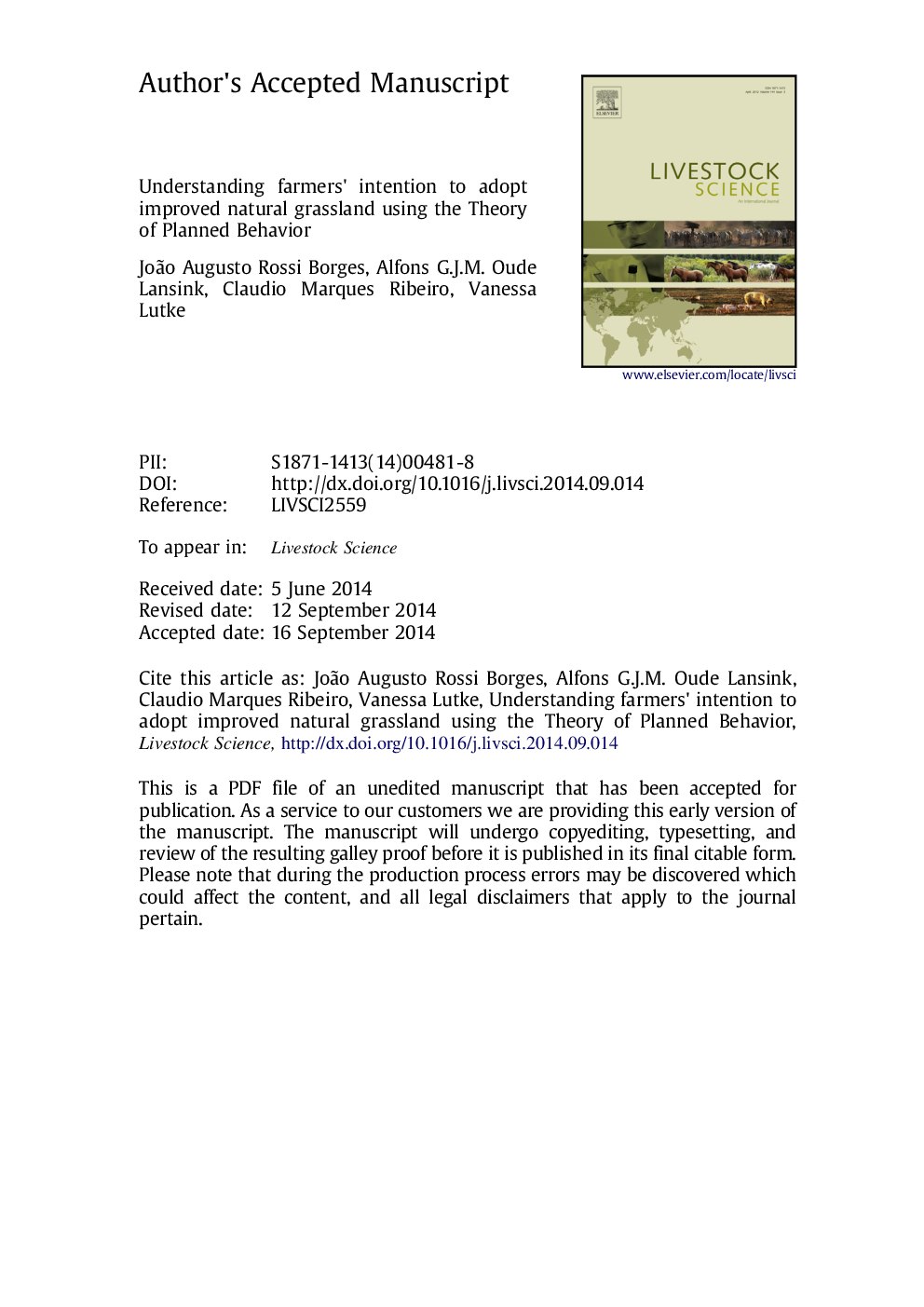| کد مقاله | کد نشریه | سال انتشار | مقاله انگلیسی | نسخه تمام متن |
|---|---|---|---|---|
| 5790145 | 1553963 | 2014 | 41 صفحه PDF | دانلود رایگان |
عنوان انگلیسی مقاله ISI
Understanding farmers' intention to adopt improved natural grassland using the theory of planned behavior
ترجمه فارسی عنوان
درک اهداف کشاورزان برای تطبیق بهتر چمنزارهای طبیعی با استفاده از تئوری رفتار برنامه ریزی شده
دانلود مقاله + سفارش ترجمه
دانلود مقاله ISI انگلیسی
رایگان برای ایرانیان
کلمات کلیدی
نظریه رفتار برنامه ریزی شده، تصویب، بهبود علفزار طبیعی، تصمیم کشاورزان،
موضوعات مرتبط
علوم زیستی و بیوفناوری
علوم کشاورزی و بیولوژیک
علوم دامی و جانورشناسی
چکیده انگلیسی
Studies on the adoption of innovations usually ignore underlying psychological constructs that affect farmers' decisions and behavior, such as intention, perceptions, and beliefs. This paper uses psychological constructs from the theory of planned behavior (TPB) to analyze factors that affect the adoption of improved natural grassland. The TPB hypothesizes that adoption is driven by intention, which in turn is determined by three psychological constructs: attitude, subjective norm, and perceived behavioral control. These three psychological constructs are derived from behavioral, normative and control beliefs, respectively. The first objective was to identify the influence of attitude, subjective norm, and perceived behavioral control on the intention of farmers to use improved natural grassland. The second objective was to understand the role of farmers' beliefs as drivers of their attitude, subjective norm, and perceived behavioral control. The theoretical framework and model were applied to a sample of 214 Brazilian cattle farmers. Results showed that attitude, subjective norm, and perceived behavioral control were all positively and significantly correlated with intention. The intention of farmers to use improved natural grassland was therefore influenced by farmers' evaluation of the use of improved natural grassland (attitude), their perceptions about the social pressure to use this innovation (subjective norm), and their perceptions about their own capability (perceived behavioral control). Six behavioral beliefs were the drivers of attitude: increase cattle weight gains, increase number of animals per hectare, have pasture throughout the year, increase pasture resistance, prevent soil erosion, and decrease feeding costs. Seven normative beliefs were the drivers of subjective norm: family, friends, neighbor farmers, cattle traders, workers in the place where they buy their inputs, extension agents, and government. Three control beliefs were the drivers of perceived behavioral control: sufficient knowledge, sufficient skills, and availability of qualified technical assistance. The drivers of attitude, subjective norm, and perceived behavioral control can be used by policy makers to increase the adoption rate of improved natural grassland. Emphasis should be given to the six perceived benefits of adopting improved natural grassland, the drivers of attitude. The individuals and groups who were found to influence farmers׳ decisions to use it, the drivers of subjective norm, can be used as channels to disseminate information about the innovation. The drivers of perceived behavioral control are factors which facilitate the use of improved natural grassland. Ensuring that these three factors are available to farmers can improve the adoption rate for this innovation.
ناشر
Database: Elsevier - ScienceDirect (ساینس دایرکت)
Journal: Livestock Science - Volume 169, November 2014, Pages 163-174
Journal: Livestock Science - Volume 169, November 2014, Pages 163-174
نویسندگان
João Augusto Rossi Borges, Alfons G.J.M. Oude Lansink, Claudio Marques Ribeiro, Vanessa Lutke,
